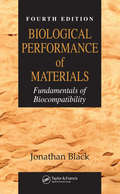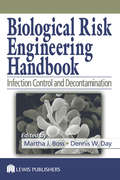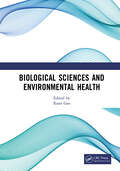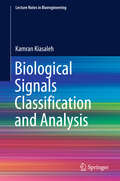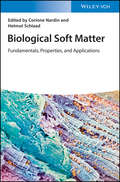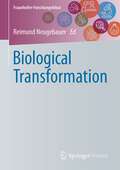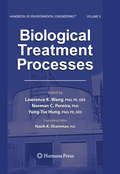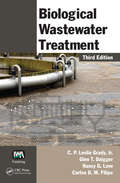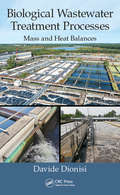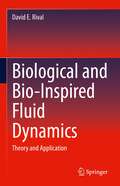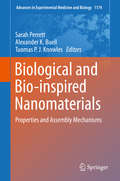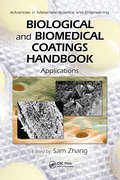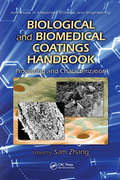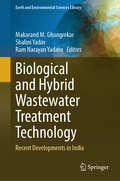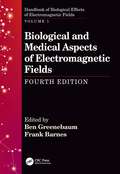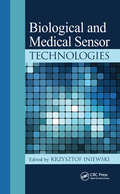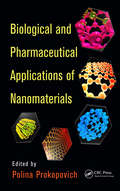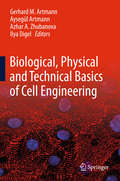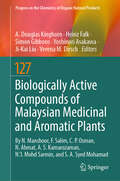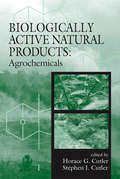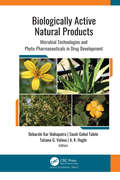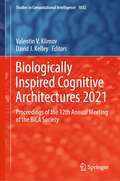- Table View
- List View
Biological Performance of Materials: Fundamentals of Biocompatibility, Fourth Edition
by Jonathan BlackBioengineers need a thorough grounding in biocompatibility - the biological performance of materials. Until now, there were no publications suitable for a neophyte in the field; prior publications were either not comprehensive or focused on rather narrow interests. Drawing on the author's 35 years of experience as a teacher, researcher, and consult
Biological Processing of Solid Waste
by Sunil Kumar, Zengqiang Zhang, Mukesh Kumar Awasthi, and Ronghua LiOffering a comprehensive approach, this title covers fundamentals, technologies, and management of biological processing of solid waste. It discusses kinetic modeling and synergistic impact evolution during bioprocessing of solid waste, environmental impacts such as greenhouse gas emission from biological processing of solid waste, energy recovery from solid waste, and biodrying of solid waste. It also presents cases and challenges from different countries, successful business models, and economic analyses of various processing options. Aimed at researchers and industry professionals in solid and hazardous waste management, this title offers a wealth of knowledge to help readers understand this increasingly important area.
Biological Risk Engineering Handbook: Infection Control and Decontamination (Industrial Hygiene Engineering)
by Martha J. Boss CSP Dennis W. DayThis handbook discusses biological risk engineering, an extension of industrial hygiene that involves the assessment, control, and decontamination of indoor biological risks. The book synergizes the knowledge of experts in various fields, from law to toxicology, to provide a compendium of information for applying science to limit biological risk.
Biological Sciences and Environmental Health: International Conference on Frontiers of Biological Sciences and Environmental Health (FBSEH 2023), November 3-5, 2023, Singapore
by Xuan GaoThe book captures the essence of the First International Conference on Frontiers of Biological Sciences and Environmental Health (FBSEH 2023). It provides a comprehensive roadmap to achieving sovereignty, security and safety of human health by adopting a multi-disciplinary approach to disease diagnosis, mitigation and prevention.These proceedings contains a repository of unique ideas, cutting edge research methodologies and exhaustive studies by experts, scholars from all over the world. It touches upon a wide array of topics including advances in bioengineering and genetic technologies, nutrition and disease prevention, emerging therapeutic strategies and drug delivery, along with the advent of microfluidics, wearables, and medical devices. It highlights innovative research contributions and practical applications that would prove critical in fighting cancer and genetic disorders in the future. This is a highly beneficial guide to university professors, research scholars and medical professionals in the rapidly evolving fields such as microbiology, biotechnology, biomedical engineering, molecular medicine, public health and community medicine, and healthcare sciences.
Biological Signals Classification and Analysis (Lecture Notes in Bioengineering)
by Kamran KiasalehThis authored monograph presents key aspects of signal processing analysis in the biomedical arena. Unlike wireless communication systems, biological entities produce signals with underlying nonlinear, chaotic nature that elude classification using the standard signal processing techniques, which have been developed over the past several decades for dealing primarily with standard communication systems. This book separates what is random from that which appears to be random and yet is truly deterministic with random appearance. At its core, this work gives the reader a perspective on biomedical signals and the means to classify and process such signals. In particular, a review of random processes along with means to assess the behavior of random signals is also provided. The book also includes a general discussion of biological signals in order to demonstrate the inefficacy of the well-known techniques to correctly extract meaningful information from such signals. Finally, a thorough discussion of recently proposed signal processing tools and methods for addressing biological signals is included. The target audience primarily comprises researchers and expert practitioners but the book may also be beneficial for graduate students.
Biological Soft Matter: Fundamentals, Properties, and Applications
by Corinne NardinExplore a comprehensive, one-stop reference on biological soft matter written and edited by leading voices in the field Biological Soft Matter: Fundamentals, Properties and Applications delivers a unique and indispensable compilation of up-to-date knowledge and material on biological soft matter. The book presents a thorough overview about biological soft matter, beginning with different substance classes, including proteins, nucleic acids, lipids, and polysaccharides. It goes on to describe a variety of superstructures and aggregated and how they are formed by self-assembly processes like protein folding or crystallization. The distinguished editors have included materials with a special emphasis on macromolecular assembly, including how it applies to lipid membranes, DNA condensation, and DNA fibrillization. Biological Soft Matter is a crucial resource for anyone working in the field, compiling information about all important substance classes and their respective roles in forming superstructures. The book is ideal for beginners and experts alike and makes the perfect guide for chemists, physicists, and life scientists with an interest in the area. Readers will also benefit from the inclusion of: An introduction to DNA nano-engineering and DNA-driven nanoparticle assembly Explorations of polysaccharides and glycoproteins, engineered biopolymers, and engineered hydrogels Discussions of macromolecular assemblies, including liquid membranes and small molecule inhibitors for amyloid aggregation A treatment of inorganic nanomaterials as promoters and inhibitors of amyloid fibril formation An examination of a wide variety of natural and artificial polymers Perfect for materials scientists, biochemists, polymer chemists, and protein chemists, Biological Soft Matter: Fundamentals, Properties and Applications will also earn a place in the libraries of biophysicists and physical chemists seeking a one-stop reference summarizing the rapidly evolving topic of biological soft matter.
Biological Transformation
by Reimund NeugebauerThe global population is expected to rise to 9.8 billion by the year 2050 - with everyone ultimately striving for prosperity. New methods must therefore be found to achieve more efficient production. Research to date shows that the biological inventory that has evolved: its products, processes, principles and tools, can spur modern technology. The development of technological innovations based on biological concepts, with the goal of particularly innovative and sustainable value creation, today is collectively known as "biological transformation". It results in highly functional products with striking properties that can be both manufactured and utilized in a resource-saving way.In terms of taking responsibility of the good of all people, biological transformation is therefore a path that applied research will have to take. The Fraunhofer-Gesellschaft has recognized the developmental technology potential of biological transformation and sees it as its task not only to drive the relevant research forward, but also to promote public awareness of the topic.
Biological Treatment Processes: Volume 8 (Handbook of Environmental Engineering #8)
by Lawrence K. Wang Yung-Tse Hung Nazih K. Shammas Norman C. PereiraPollution and its effects on the environment have emerged as critical areas of research within the past 30 years. The Handbook of Environmental Engineering is a collection of methodologies that study the effects of pollution and waste in their three basic forms: gas, solid, and liquid. In Volume 8, Biological Treatment Processes, tried-and-true solutions comprise a "methodology of pollution control". The distinguished panel of authors contributes detailed chapters, which include topics ranging from treatment by land application, activated sludge processes, and submerged aeration to trickling filters, lagoons, rotating biological contactors, sequencing batch reactors, digestions, and composting. Volume 8 and its sister book - Volume 9: Advanced Biological Treatment Processes - are designed as both basic biological waste treatment textbooks and reference books for advanced undergraduate and graduate students - as well as for designers of waste treatment systems, scientists, and researchers. An indispensable addition to the Humana Press series, Volume 8: Biological Treatment Processes provides an illuminating look at water pollution control and the fascinating evolution of bio-environmental engineering.
Biological Treatment of Waste and By-Products from Food Industry (SpringerBriefs in Applied Sciences and Technology)
by Wojciech CzekałaThis book discusses selected waste and by-products of the food industry. Two commonly used methods of managing these are discussed: anaerobic digestion and composting. The book reviews current research and also brings in the author’s own research insights to the discussion. The book is aimed at food industry specialists, waste management specialists, scientists, and students. However, the book describes problems in an accessible way, which will make this book useful for beginners in the waste/biogas/composting sector.
Biological Wastewater Treatment
by Glen T. Daigger C. P. Grady Jr. Nancy G. Love Carlos D. FilipeFollowing in the footsteps of previous highly successful and useful editions, Biological Wastewater Treatment, Third Edition presents the theoretical principles and design procedures for biochemical operations used in wastewater treatment processes. It reflects important changes and advancements in the field, such as a revised treatment of the micr
Biological Wastewater Treatment Processes: Mass and Heat Balances
by Davide DionisiThe focus of the book is on how to use mass and heat balances to simulate and design biological wastewater treatment processes. All the main processes for biological wastewater treatment are covered viz. activated sludge processes for carbon and nitrogen removal, anaerobic digestion, sequencing batch reactors, and attached growth processes.
Biological and Bio-Inspired Fluid Dynamics: Theory and Application
by David E. RivalThis text provides the reader with tools necessary to study biological and bio-inspired flows, all the while developing an appreciation for their evolutionary and engineering constraints. It is suitable for students already exposed to introductory concepts in fluid mechanics and applied mechanics as a whole, but who would not need an advanced training in fluid mechanics per se. Currently no textbook exists that can take students from an introductory position in fluid mechanics to these contemporary topics of interest. The book is ideal for upper-level undergraduates and graduate students studying a range of engineering domains as well as biology, or even medicine.
Biological and Bio-inspired Nanomaterials: Properties and Assembly Mechanisms (Advances in Experimental Medicine and Biology #1174)
by Sarah Perrett Alexander K. Buell Tuomas P. J. KnowlesThis book summarizes naturally occurring and designed bio-inspired molecular building blocks assembled into nanoscale structures. It covers a fascinating array of biomimetic and bioinspired materials, including inorganic nanozymes, structures formed by DNA origami, a wide range of peptide and protein-based nanomaterials, as well as their applications in diagnostics and therapeutics. The book elucidates the mechanism of assembly of these materials and characterisation of their mechanical and physico-chemical properties which inspires readers not only to exploit the potential applications of nanomaterials, but also to understand their potential risks and benefits. It will be of interest to a broad audience of students and researchers spanning the disciplines of biology, chemistry, engineering, materials science, and physics.
Biological and Biomedical Coatings Handbook: Applications (Advances in Materials Science and Engineering)
by Sam ZhangWritten in a versatile, contemporary style that will benefit both novice and expert alike, Biological and Biomedical Coatings Handbook, Two-Volume Set covers the state of the art in the development and implementation of advanced thin films and coatings in the biological field. Consisting of two volumes-Processing and Characterization and Applicatio
Biological and Biomedical Coatings Handbook: Processing and Characterization
by Sam ZhangWritten in a versatile, contemporary style that will benefit both novice and expert alike, Biological and Biomedical Coatings Handbook, Two-Volume Set covers the state of the art in the development and implementation of advanced thin films and coatings in the biological field. Consisting of two volumes-Processing and Characterization and Applicatio
Biological and Hybrid Wastewater Treatment Technology: Recent Developments in India (Earth and Environmental Sciences Library)
by Shalini Yadav Ram Narayan Yadava Makarand M. GhangrekarThis book provides technical information on different biological and hybrid wastewater treatment systems for the treatment of wastewater and reuse, and tracks their progress towards practical and field-scale applications including strategies to be adopted for minimizing the losses and maximizing the benefits, as well as protecting the environment through the application of advanced biological and hybrid wastewater treatment Technology. In addition, it discusses the crucial parts that science, technology, and innovation play in the formulation, implementation, and administration of wastewater treatment policy. It highlights the challenges that must be overcome to adopt biological and hybrid wastewater treatment infrastructure regulations successfully and provides some answers. Also, it investigates how the biological and hybrid wastewater treatment technology may be used in a wide variety of field's sets apart from other on-the-shelf publications on the market. Also, it delves into the core concepts of Biological and Hybrid Wastewater Treatment Systems. It explores how these concepts can be modified to fit a variety of contexts and uses. Applications such as managing facilities, dealing with pandemics, urban wastewater treatment and reuse, farming, and other applications are included in this book. As a consequence, this book's content is engaging, and it will pique the interest of a diverse audience of readers who come from a wide variety of different professional backgrounds. Therefore, the book is written by local experts in the topic who dealing with the treatment of wastewater treatment technologies for a long time in India. This book will be helpful to researchers, entrepreneurs, professionals, planners, policymakers, environmental engineers, and others interested in biological and hybrid wastewater treatment system management strategies through the application of breakthroughs in biological and hybrid wastewater treatment technologies.
Biological and Medical Aspects of Electromagnetic Fields, Fourth Edition (Handbook of Biological Effects of Electromagnetic Fields)
by Frank Barnes Ben GreenebaumThe two volumes of this new edition of the Handbook cover the basic biological, medical, physical, and electrical engineering principles. They also include experimental results concerning how electric and magnetic fields affect biological systems—both as potential hazards to health and potential tools for medical treatment and scientific research. They also include material on the relationship between the science and the regulatory processes concerning human exposure to the fields. Like its predecessors, this edition is intended to be useful as a reference book but also for introducing the reader to bioelectromagnetics or some of its aspects. FEATURES • New topics include coverage of electromagnetic effects in the terahertz region, effects on plants, and explicitly applying feedback concepts to the analysis of biological electromagnetic effects • Expanded coverage of electromagnetic brain stimulation, characterization and modeling of epithelial wounds, and recent lab experiments on at all frequencies • Section on background for setting standards and precautionary principle • Discussion of recent epidemiological, laboratory, and theoretical results; including: WHO IARC syntheses of epidemiological results on both high and low frequency fields, IITRI lab study of cancer in mice exposed to cell phone-like radiation, and other RF studies • All chapters updated by internationally acknowledged experts in the field
Biological and Medical Sensor Technologies (Devices, Circuits, and Systems)
by Krzysztof IniewskiBiological and Medical Sensor Technologies presents contributions from top experts who explore the development and implementation of sensors for various applications used in medicine and biology. Edited by a pioneer in the area of advanced semiconductor materials, the book is divided into two sections. The first part covers sensors for biological applications. Topics include: Advanced sensing and communication in the biological world DNA-derivative architectures for long-wavelength bio-sensing Label-free silicon photonics Quartz crystal microbalance-based biosensors Lab-on-chip technologies for cell-sensing applications Enzyme biosensors Future directions for breath sensors Solid-state gas sensors for clinical diagnosis The second part of the book deals with sensors for medical applications. This section addresses: Bio-sensing and human behavior measurements Sweat rate wearable sensors Various aspects of medical imaging The future of medical imaging Spatial and spectral resolution aspects of semiconductor detectors in medical imaging CMOS SSPM detectors CdTe detectors and their applications to gamma-ray imaging Positron emission tomography (PET) Composed of contributions from some of the world’s foremost experts in their respective fields, this book covers a wide range of subjects. It explores everything from sensors and communication systems found in nature to the latest advances in manmade sensors. The end result is a useful collection of stimulating insights into the many exciting applications of sensor technologies in everyday life.
Biological and Pharmaceutical Applications of Nanomaterials
by Polina ProkopovichBiological and Pharmaceutical Applications of Nanomaterials presents the findings of cutting-edge research activities in the field of nanomaterials, with a particular emphasis on biological and pharmaceutical applications. Divided into four sections-nanomaterials for drug delivery, antimicrobial nanomaterials, nanomaterials in biosensors, and safet
Biological, Physical and Technical Basics of Cell Engineering
by Gerhard M. Artmann Aysegül Artmann Azhar A. Zhubanova Ilya DigelThis book presents and discusses recent scientific progress on Cell and Stem Cell Engineering. It predominantly focuses on Biological, Physical and Technical Basics, and features new trends of research reaching far into the 21st century.
Biologically Active Compounds of Malaysian Medicinal and Aromatic Plants (Progress in the Chemistry of Organic Natural Products #127)
by A. Douglas Kinghorn Heinz Falk Simon Gibbons Yoshinori Asakawa Ji-Kai Liu Verena M. DirschThis volume explores the biologically active compounds found in 21 high-value medicinal and aromatic plant species native to Malaysia, emphasizing their phytochemical diversity and biological activities. Several of these plants, including Eurycoma longifolia, Andrographis paniculata, Morinda citrifolia, Centella asiatica, and Moringa pleifera, have been prioritized as high-priority herbal products under Malaysia's National Key Economic Area in the Eleventh Malaysia Plan. Their importance transcends traditional herbal medicine, as they are increasingly recognized for their potential contributions to the national economy and modern healthcare. The volume describes the pharmacological properties of these plants, highlighting their anti-inflammatory, antioxidant, antimicrobial, and cytotoxic activities. It also encompasses aromatic plants like Clinacanthus nutans, Cananga odorata, Citrus hystrix, and Polygonum minus, focusing on their bioactive compounds and potential therapeutic and industrial uses.
Biologically Active Natural Products: Agrochemicals
by Horace G. Cutler Stephen J. CutlerNatural products that have both plant growth regulatory properties and pharmaceutical properties are examined in this book. This is the first and most up-to-date text linking agrochemistry and pharmaceutical chemistry in an easy to read presentation for practitioners in both fields. Due to the intense and widespread attention being given to
Biologically Active Natural Products: Microbial Technologies and Phyto-Pharmaceuticals in Drug Development
by Debarshi Kar Mahapatra; Swati Gokul Talele; Tatiana G. Volova; A. K. HaghiBiologically active natural products and their substructures have long been valuable starting points for medicinal chemistry and drug discovery. This new volume explores biologically active natural products and their use in microbial technologies and as phyto-pharmaceuticals in drug development. It presents detailed scientific principles and recent research on applications of nanotechnology in diagnostics and drug delivery. Topics include pharmacotherapeutically active proteins and peptides; the biotechnological potential of hydrogen-oxidizing bacteria; synthesis and production; synthetic colorants, pigments, dyes, and lakes; and more. The use of various plants is discussed in several chapters, including Artemisia, Asteraceae, Abutilon indicum, Prosopis juliflora, Acacia arabica, Aloe barbadensis, Tabermontana divaricate Linn., among others. With the information presented in Biologically Active Natural Products: Microbial Technologies and Phyto-Pharmaceuticals in Drug Development, scientists, faculty, and graduate students will gain a unique insight into nanotechnology and natural pharmaceuticals today with practical implementation in various industrial sectors.
Biologically Active Peptides: Design, Synthesis and Utilization
by David B. Weiner William V. WilliamsInvestigation into basic and advanced peptide design, synthesis, evaluation and utilization. New therapeutic approaches from experimental systems.
Biologically Inspired Cognitive Architectures 2021: Proceedings of the 12th Annual Meeting of the BICA Society (Studies in Computational Intelligence #1032)
by Valentin V. Klimov David J. KelleyThe book focuses on original approaches intended to support the development of biologically inspired cognitive architectures. It bridges together different disciplines, including artificial intelligence, linguistics, neuro- and social sciences, psychology and philosophy of mind, among others. The chapters are based on contributions presented at the 12th Annual Meeting of the BICA Society (BICA 2021), which consisted of two parallel virtual events: Information in Biologically Inspired Cognitive Architectures based Systems, held during the 2021 Summit of the International Society for the Study of Information, on September 12-19, 2021, from Vienna, Austria, and the 2021 International Workshop on Biologically Inspired Cognitive Architectures, held during the 21st ACM International Conference on Intelligent Virtual Agents, on September 14-17, 2021, from the Fukuchiyama City, Kyoto, Japan. The book discusses emerging methods, theories and ideas towards the realization of general-purpose humanlike artificial intelligence or fostering a better understanding of the ways the human mind works. It provides engineers, mathematicians, psychologists, computer scientists and other experts with a timely snapshot of recent research and a source of inspiration for future developments in the broadly intended areas of artificial intelligence and biological inspiration.
